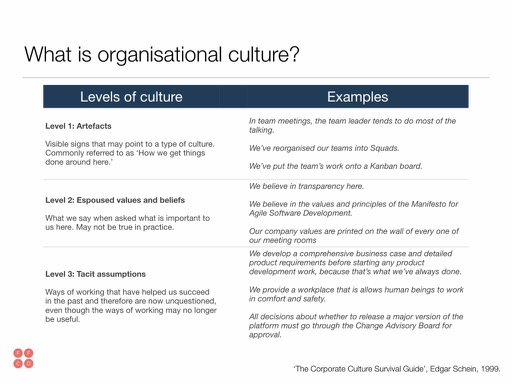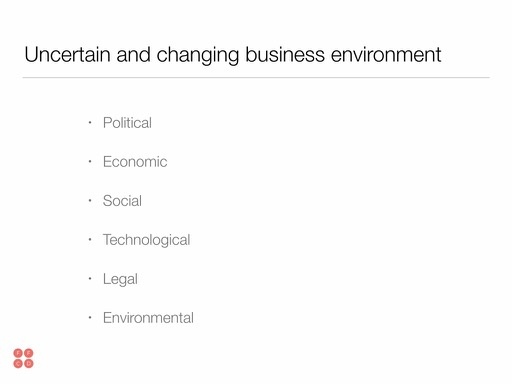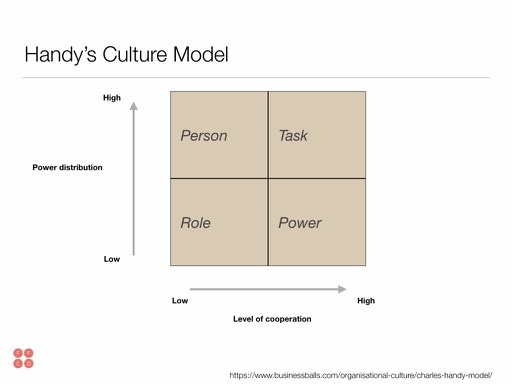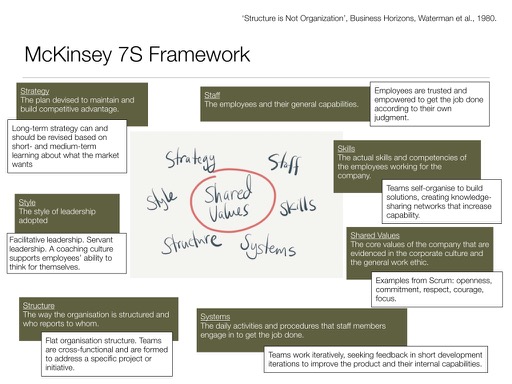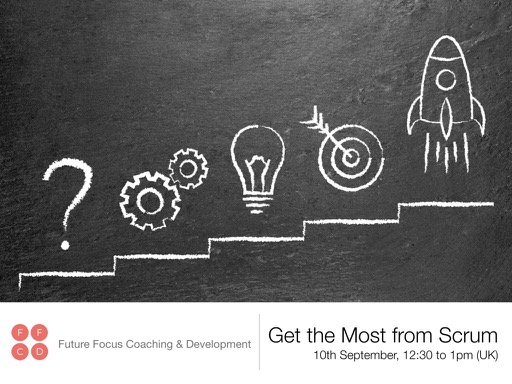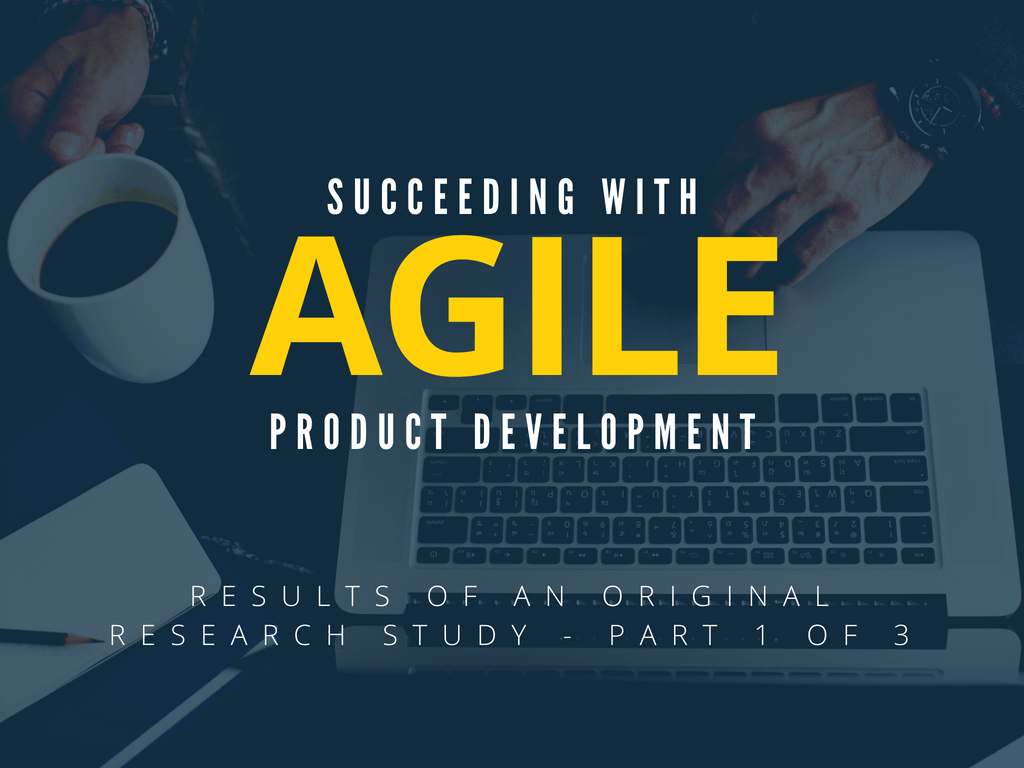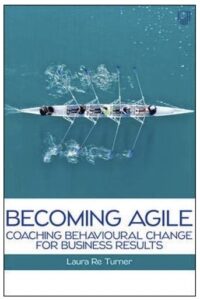
Transcript of Create an Agile Culture, from the Free Webinar Series to Create an Agile Organisation, on 21st October 2019. Presented by Laura Re Turner, Director, Future Focus Coaching, and Phil Summerfield, Executive Coach.
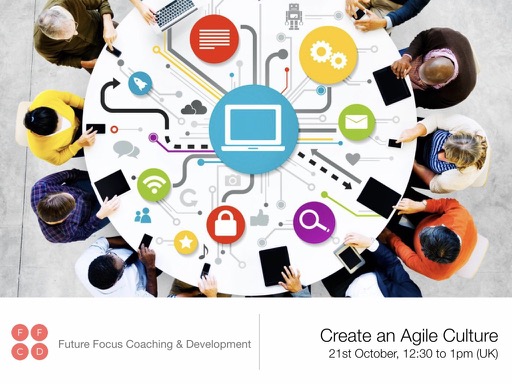
Welcome – from Laura Re Turner and Phil Summerfield
Most of you know me, Laura Re Turner, I’m an accredited Executive Coach, certified Agile Coach and a Trainer. I help leaders and their teams develop an agile mindset, behaviours and skills to succeed in the very complex and uncertain business environments that we’re operating in today. I’m also very happy today to have my friend and colleague and fellow coach Phil Summerfield with us today; he’ll be co-presenting.
Introduction
The topic of today’s webinar was inspired by questions that we’ve heard so many times from our clients:
“What beliefs and mindset do we really need to have here in order to be successful with agile methods?“
“If we’re going to be successful with Scrum, what is it that we really need to do at the most fundamental level?”
”How do we change the mindset of others?”
“How do we get other people to come along with us and how should we measure success?”
What is organisational culture?
So what is organisational culture? It’s such a big topic and when looking into it we found out that most organisations think about culture as how we get things done around here. That’s the definition that’s given most often. In fact, when we really read the literature on organisational culture specifically Edgar Schein, we found out that “how we get things done around here” typically only points to the visible signs of culture. For example, a leaders reorganise teams into squads or Scrum teams. We’ve also seen many times that a leader gets the team to use a team board or Kanban board and points to that as an example of things changing, becoming more agile. It’s an indication that something is changing but it really doesn’t get right to the heart of the organisation’s culture.
Also things that we can observe are things like in team meetings, the team leader tends to do most of the talking. We don’t know why, we don’t know the reasoning behind some of these action plans or artefacts or visible things that organisations. They start to indicate a certain culture but they don’t tell the whole story — just the tip of the iceberg. Schein describes another level of culture which isn’t as obvious as things like putting our work on a Kanban board. He calls this ‘level two: espoused values and beliefs’. Or, ‘what we say when asked what’s important to us here.’ The trouble is that these things may not be true all the time in practice.
I have a few examples in an Agile context, and I think everyone can relate to some of these. For example, we believe in transparency here. We probably do believe in transparency but we may not have transparency all the time. We believe in the values and principles of the Manifesto for Agile Software Development, but we still micro-manage the team by asking project manager to track technical tasks. Our company values are printed on the wall of every one of our meeting rooms, but nobody remembers what they are.
Schein says that company culture is really influenced by the unconscious beliefs and assumptions that we have about the best ways to work here, the ways of working that have helped us succeed in the past and therefore are taken for granted unquestioned even though some of these ways of working may no longer be useful. And the technical description for that is tacit assumptions.
Here are a few examples:
We develop a comprehensive business case and detailed product requirements before starting any product development work [because that’s what we’ve always done here].
We provide a workplace that allows human beings to work in comfort and safety because that’s important to us, it’s what we value — a workplace that’s physically comfortable and safe for work.
All decisions about whether to release a major version of the platform must go through the Change Advisory Board for approval because releases of new functionality to the production environment are risky.
Uncertain and changing business environment
What we want to have a look at next is the influence of change coming from the external business environment. This is where I would love to hand over to Phil. He’ll talk to you about the PESTLE model and the uncertain and changing business environment.
The PESTLE model helps us think about the different sources of change:
- Political
- Economic
- Social
- Technological
- Legal
- Environmental.
I’m going to use the UK and Apple as examples. What I suggest you might want to do is just note down any thoughts about your own organisation while we’re going through this.
Political– a current one, I won’t go into any detail, changes in our regional trade agreements. You may have your own views on those and using Apple as an example more global how they’re operating in China and the factors that are changing for them there.
Economic– are new tariffs on goods imported into the UK or there could be for a company like Capo as China which does a lot of its development most of it as the society increases or improves rather, the labour costs will increase. How will that affect their business? That’s a massive impact on them there.
Social– the different working expectations of the younger generations these days it’s really starting to have an impact on business because it’s not a job for life anymore so people think and behave in different ways and have different expectations. In the case of Apple, they’re looking at third world use of technology. Is that a dramatically big new market for them or maybe they’re not so interested in it.
Technological– that’s a big thing these days. The disruption caused by new innovations, new ways of working and very relevant to what we’re talking about today. With a company like Apple, well that could flip itself over because my phone it’s also a computer; nearly everyone’s these days. It can be as good as my Laptop or notepad. Does that mean that Apple will start selling far less as more and more the different products look very similar?
Legal changes– how those affect your business national local laws or global laws. In the case of Apple, they’re moving heavily into automotive, how does that affect their insurance and regulatory costs and what happens if my Apple based Satnav directs me in the wrong place? Who do I sue? Do I sue Apple for that? So the question they’re facing there.
Environmental– that’s manufacturing processes are changing, government laws environmental laws are saying some materials we’ve used in the past are no longer acceptable because they’re a danger to society. In the case of a company like Apple, disposal of lithium batteries for instance very, very expensive. So there’s another way of looking the thermal fuse the PESTLE example here. You can also look at some new acronym of hookah, which is volatile uncertain complex and ambiguous. I guess you probably all recognise that as the business world of today.
Handy’s Culture Model
So here we’re looking at organisational culture. This was developed by an Irishman called Charles Handy who you probably all heard of; he’s written lots of books on organisational development. He identified four different cultural behaviours that organisations he looked at exhibited.
- Power, which is centralised top-down power and influence.
- The role culture and this is bureaucratic run by strict procedures and very narrowly define both roles and powers.
- Task-based, this is small teams results based and results-oriented and it’s narrowed by flexibility adaptability and empowerment.
- Person culture, which is based on the individual. It’s the people are the most important thing and even the behaviours and processes are geared towards individual success.
So just looking in a bit more detail about those going back to person. It’s really a cluster of stars successful people and the individual is the focal point. If there is any structure there, it’s only there to serve and assist individuals so it’s all about the individual here.
Task-based the emphasis here, well the focus is on the individual expertise and it’s highly, highly valued. The emphasis is getting the job done and the culture brings together the right resources, people and at the right level and at the right time to actually get the success they want which could be completing a project or a program quite common here these days. It depends totally on teamwork – totally. The teams can be formed and then reformed or abandoned where the team can decide to abandon it. So the point there is that the team has the power; they don’t need to go upstairs to actually get decisions about what they’re doing.
Role-based, this is really focusing on the allocation of work within roles. It’s really focused on very stable environments where the markets steady, predictable or controllable or perceived to be. So a good example here would have been the bank’s I guess and insurance companies very slow to change and very slow to see the need to change and they’re having major problems these days because they are role-based.
And finally the power-based organisations. This can be very successful but maybe these days for the wrong reasons. They are very successful because somebody at the centre of power like a spider in a web controls everything. The closer you are to the sense of the web the more power you’ve got and if this can feel sometimes quite unpleasant for the people working within it tough and abrasive and lead to low morale and high turnover.
Mckinsey 7S Framework
Just to carry on from that a little bit, I’d like to expand now our thinking about culture and about agile culture in particular using a model that I use quite a lot in my coaching and consulting work called McKinsey 7S. As you probably figured out it has 7 aspects in each of them starts with an “S”.
- Strategy
- Staff
- Skills
- Systems
- Structure
- Style
- Shared values.
A group of McKinsey consultants in 1980 decided that they were leading so many organisational change programs, that there needed to be a holistic way of approaching change and they found that most organisations wanted to focus on the so-called hard aspects of organisational culture more than the others. So of these I think we can guess which of the hard aspects strategy, structure and systems and people wanted to look at these aspects, the more visible or hard aspects of culture in order to make the changes that were required to help a company move forward.
It is probably no surprise by now those of you who know me and my company’s work and the focus of the webinar so far that in order to be successful with any kind of culture change we need to also focus on the softer aspects and those are of course staff, leadership style and shared values. So in order to broaden our idea of what an agile culture means I’d like to take each of these aspects of the 7S framework one by one. I’d like to give you the vanilla definition from the McKinsey Consultants from 1980 and then also give you an example of what we mean by an agile culture for each of those.
Strategy – the plan devised to maintain and build competitive advantage corporate strategy and an agile adaptation of that would look like a long-term strategy is created and can be revised, should be revised based on anything that we learn about the market as we go. In other words because of the change in external business environment our strategy doesn’t stay static. We’re learning as we go.
Staff – the employees and their general capabilities and what that means for us in an agile environment is that employees are trusted and empowered to get the job done according to their own judgment. That also means they self-organise and take on the roles that they need to in a task culture based on a specific project work or product development work that they have.
Skills – the actual skills and competencies of the employees working for the company. They self-organised to build solutions that create knowledge sharing networks as needed based on the current challenges and problems and opportunities that they’re working on in order to increase their capability. So learning is a huge part of organisations where there’s lots of uncertainty.
Shared values – the core values of the company today that are evidenced in the corporate culture and the general work ethic. Examples from the Scrum framework which are very well-known, openness, commitment to respect, courage and focus. We could quite easily point two values and any of the other Agile Frameworks because in Agile we know that values are important but Scrum is probably the best known example of those.
Systems – the daily activities and procedures that staff members engage in to get the job done. So anyone who’s been on a course with me and I think that’s a few of you, know that iterative and incremental development is the heart of all that frameworks, whether it’s Scrum or DSDM or Extreme Programming. Teams’ work iteratively seeking feedback in short development iterations, short cycles to improve the product and the teams’ internal capabilities through retrospectives.
Structure – the way the organisation is structured and who reports to whom. We tend to have flatter organisations with cross-functional teams that are formed to address specific project or initiative.
Leadership style – facilitative leadership rather than command and control. Some people also describe servant leadership, which is certainly one of the definitions of the Scrum master and Scrum. A coaching culture to support employees’ ability to think for themselves. So empowering people to think for themselves and moving away from this hub-and-spoke type of management environment to allow people to be able to work more tightly with each other rather than reporting to a single manager.
Success factors
There are a couple success factors for changing culture. Number one, definitely challenge your organisation’s tacit assumptions, the level 3, the unconscious, ways that we work that have worked for us in the past which may no longer work for us going forward in the future. Remember to think about those unconscious culture like we put all the work on a Kanban board, why haven’t we changed the culture? And second examine all aspects of an organisation not just the organisational structure. This is why the McKinsey S7 framework is so useful for this to help us stay on track.
Ready to get started? Contact us. We’ll respond within one business day.

